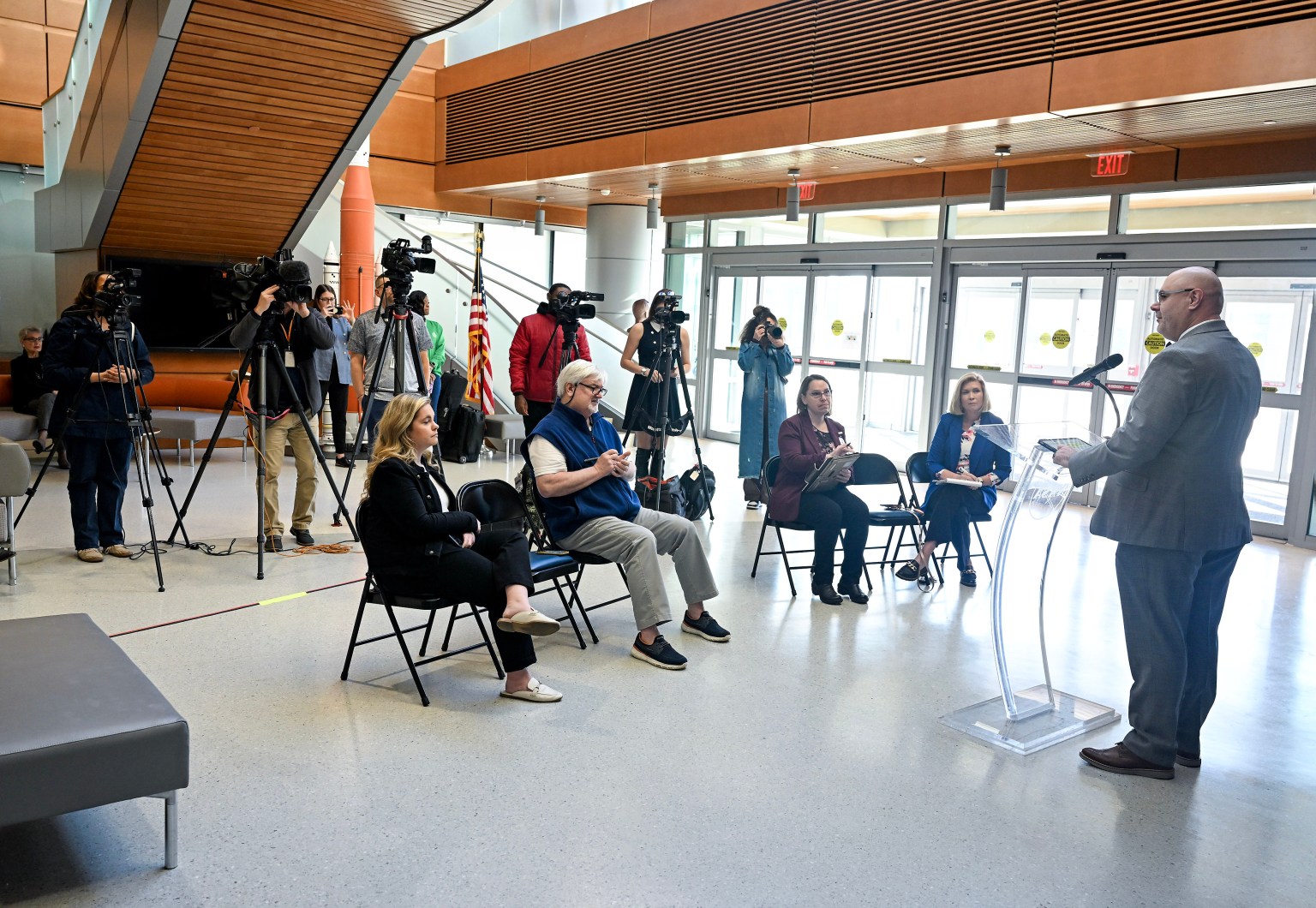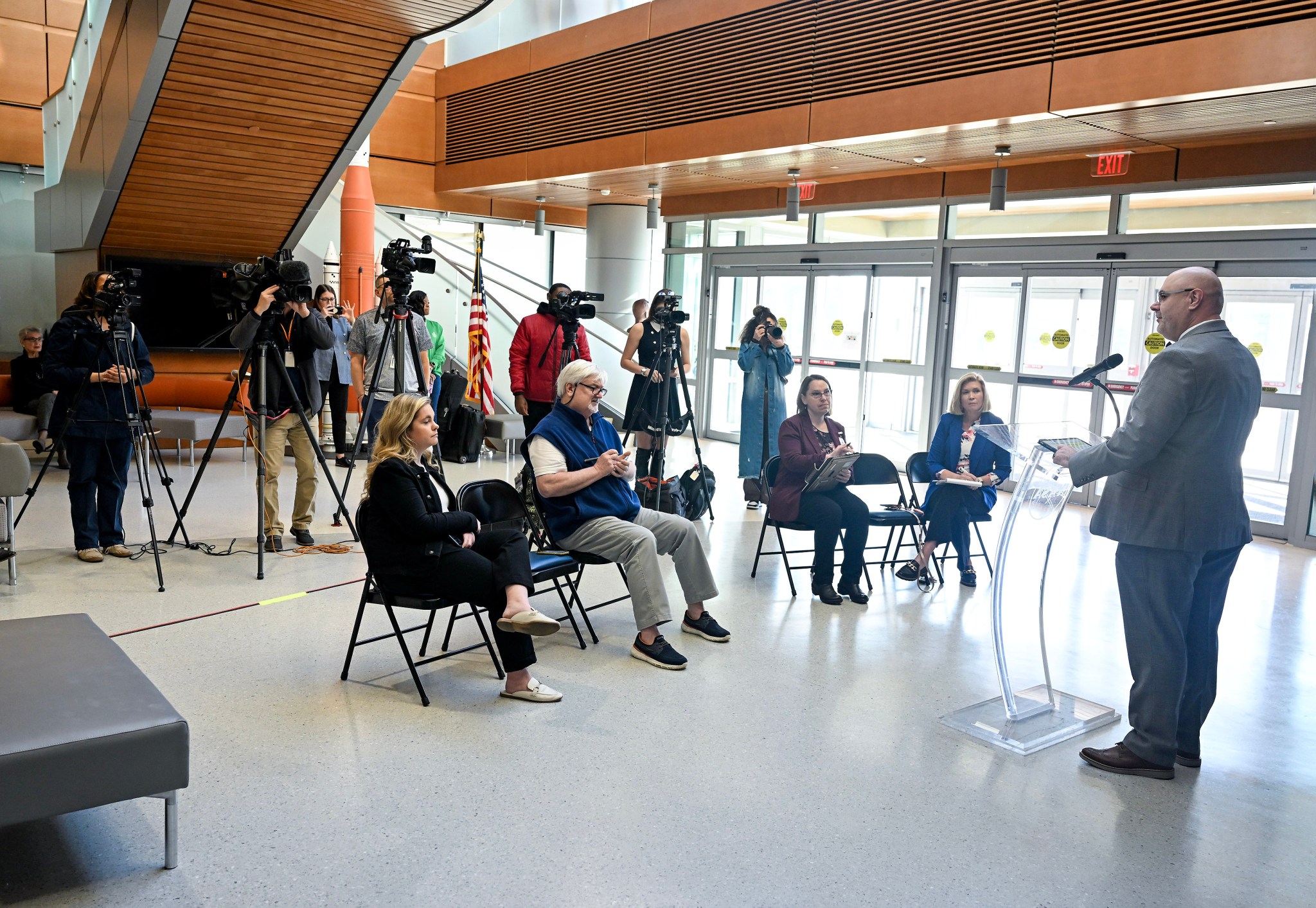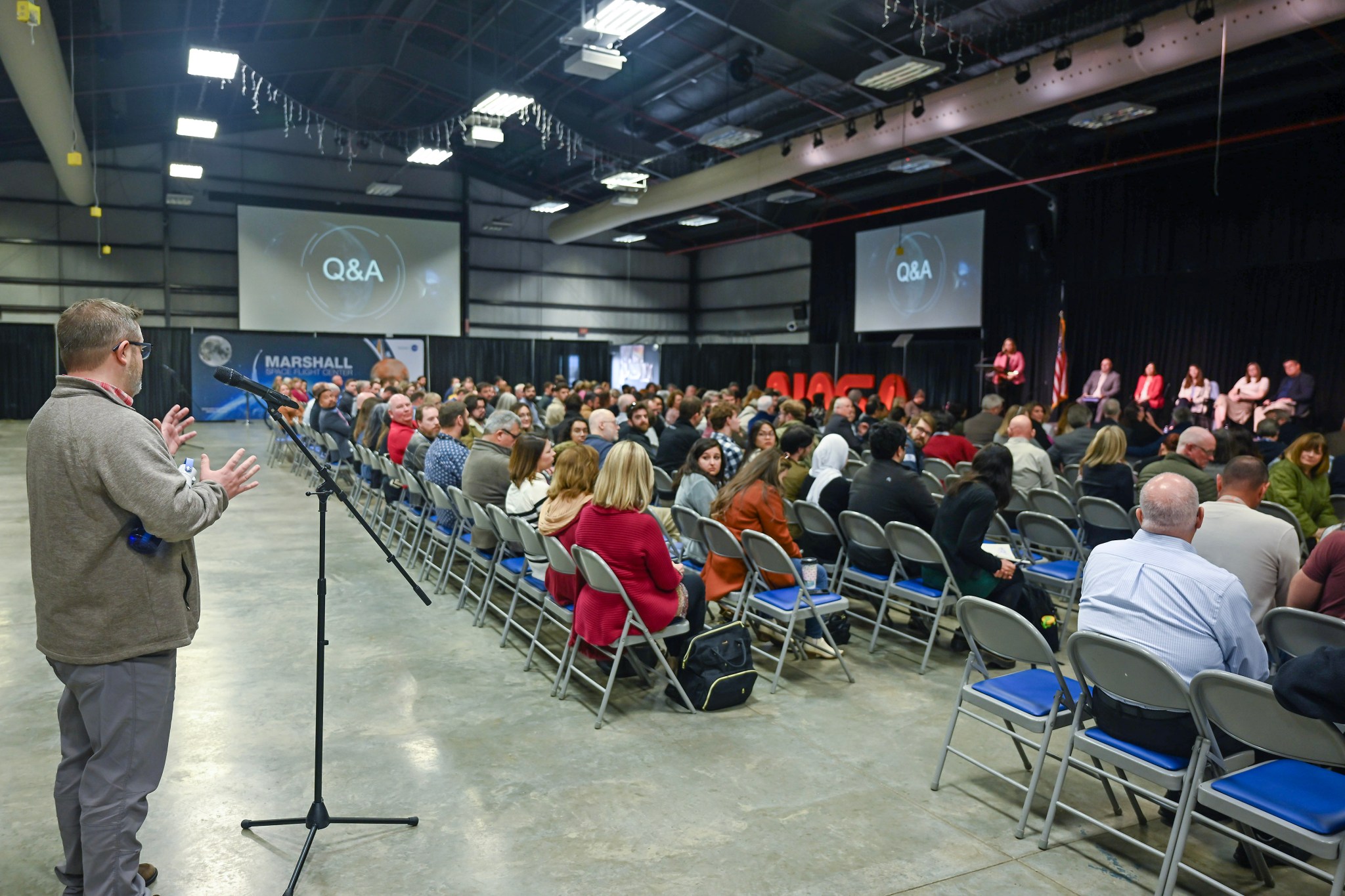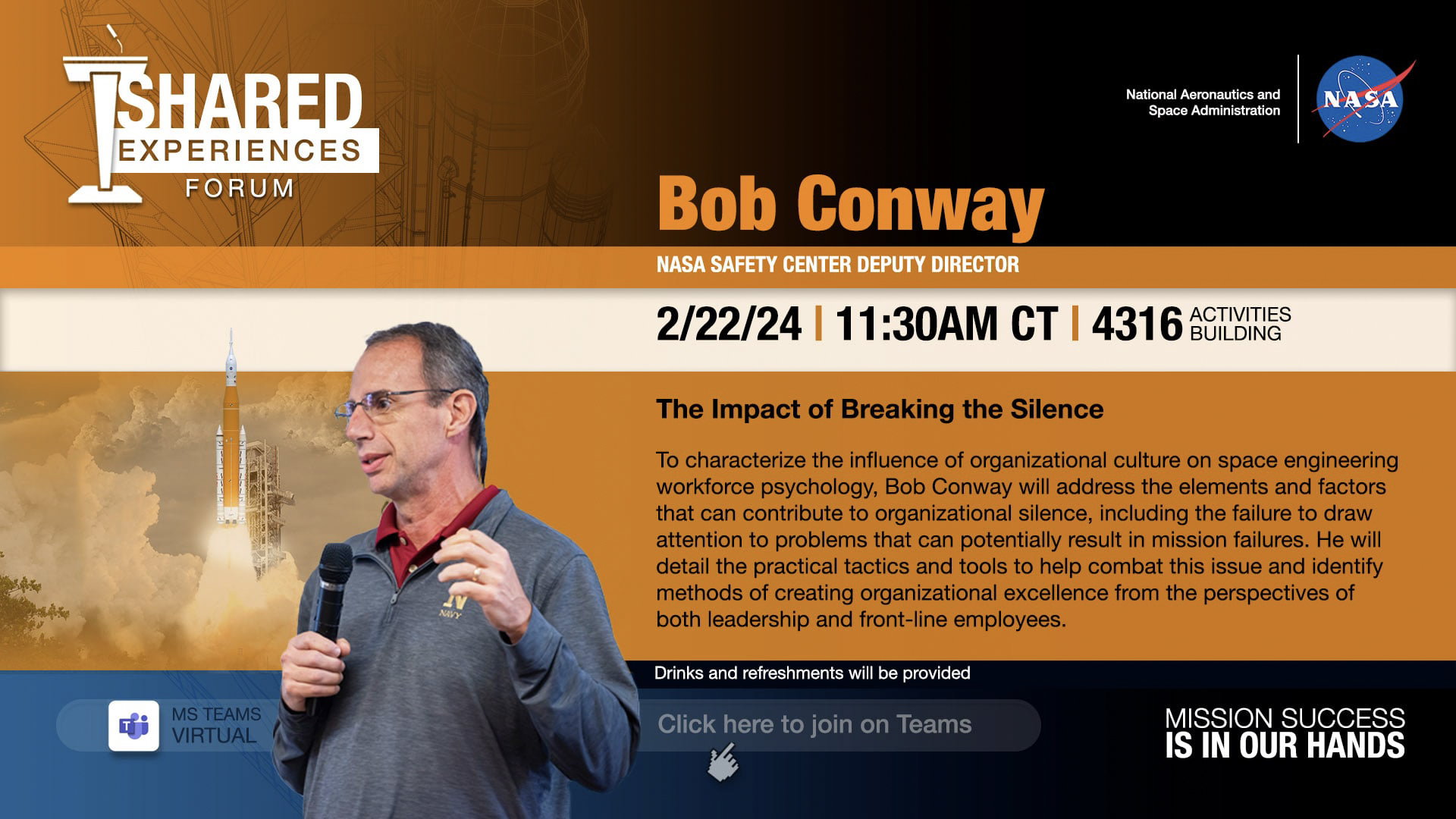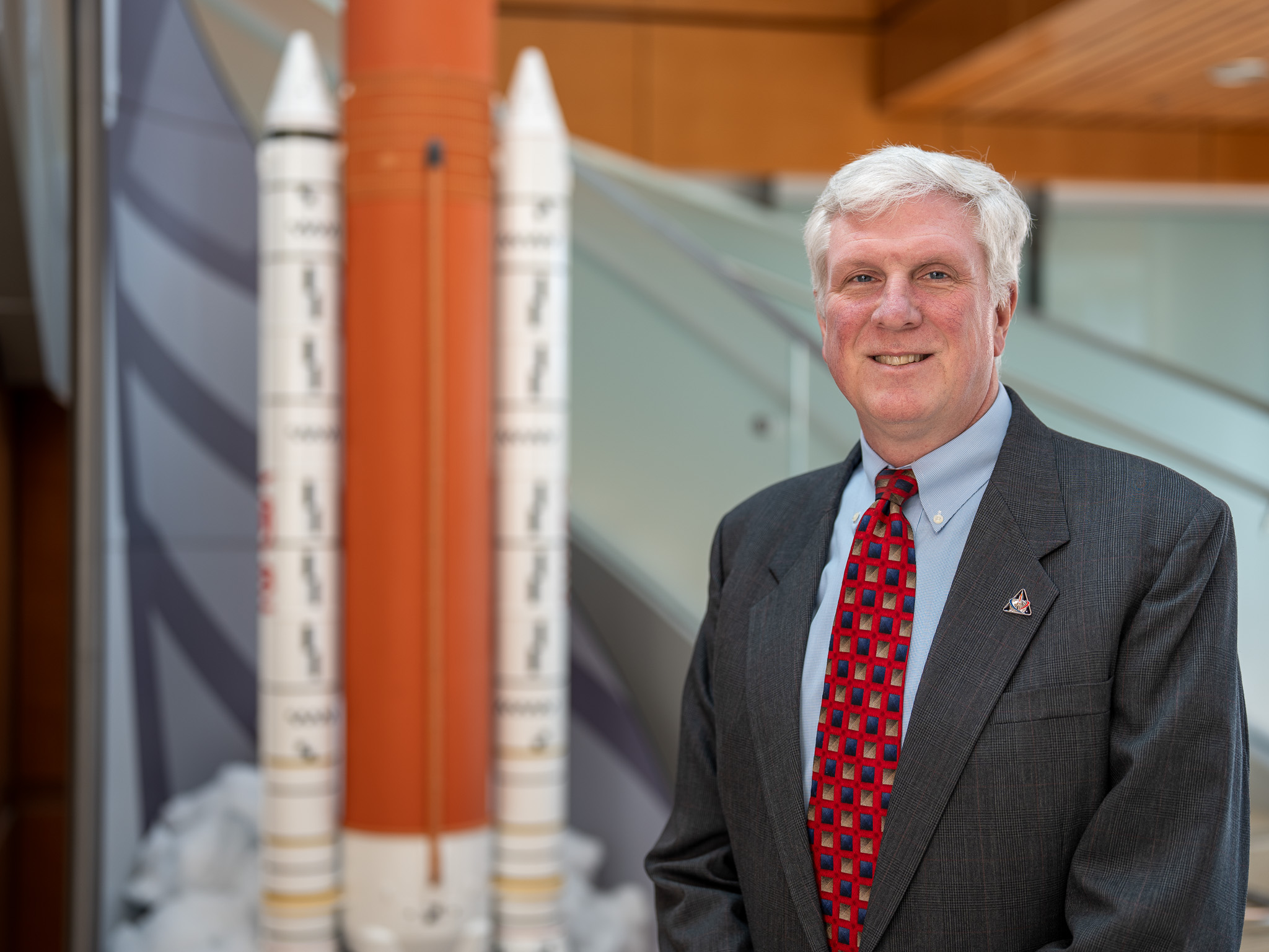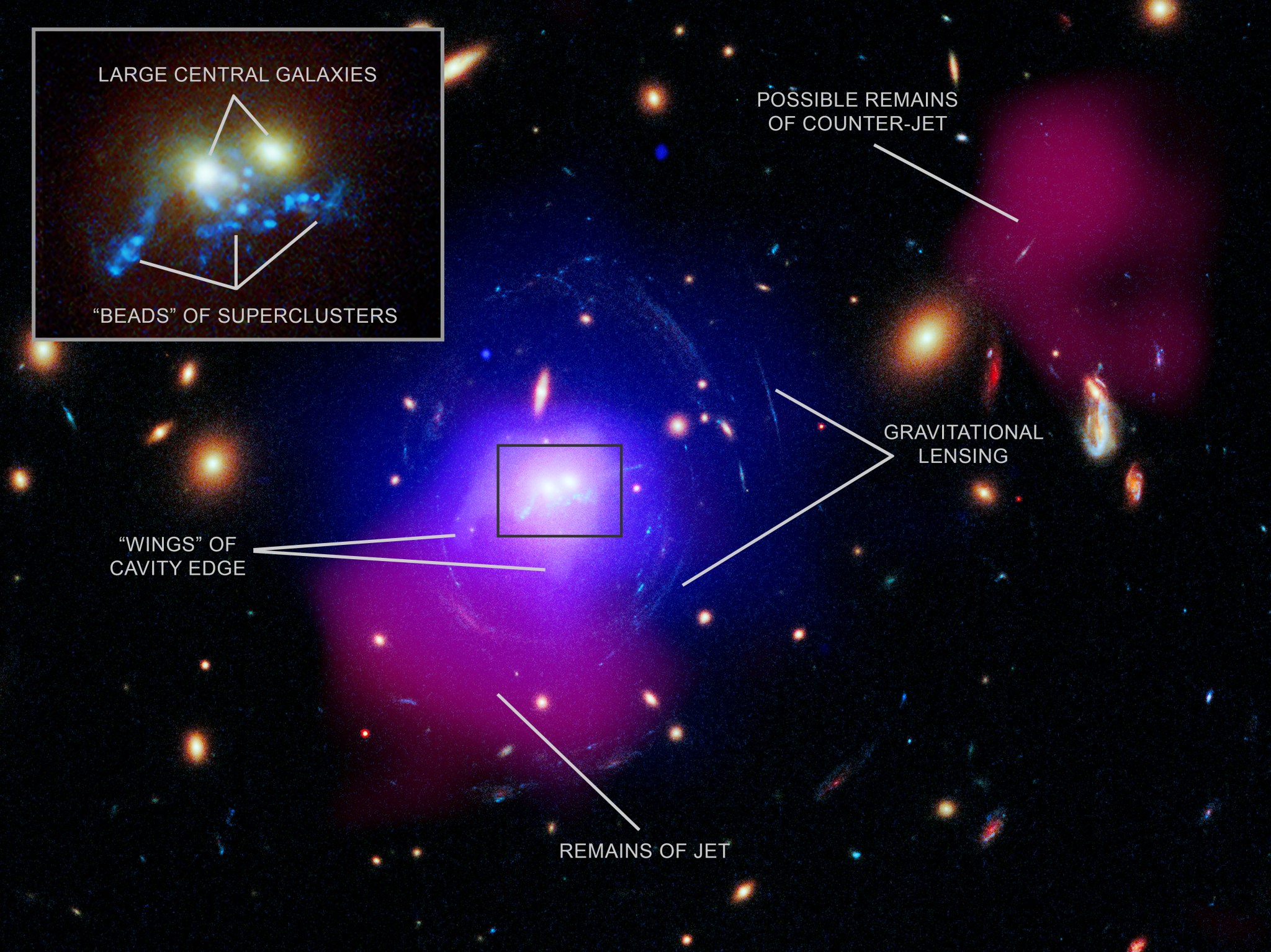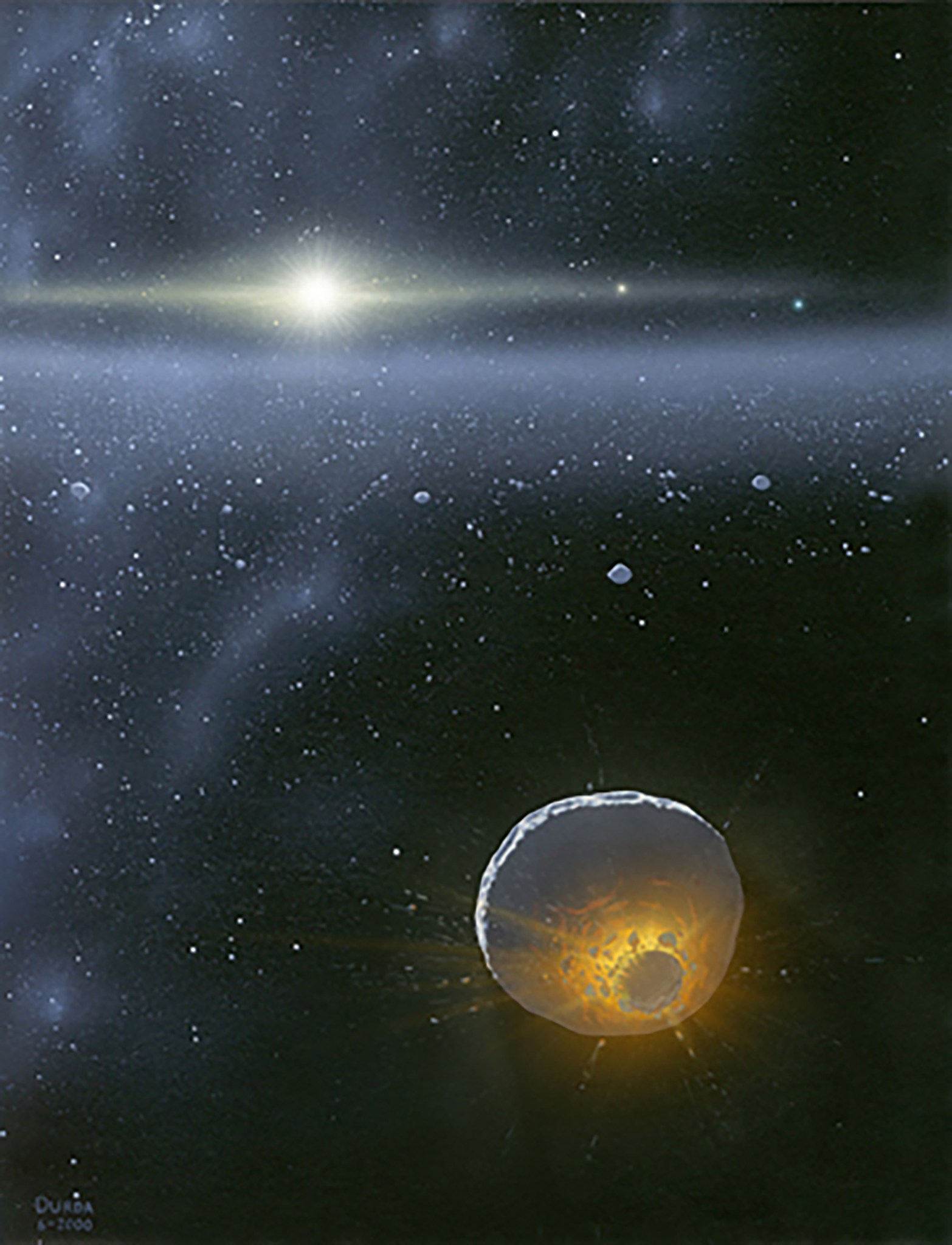Marshall Center Director Holds First Media Event
By Jessica Barnett
NASA Marshall Space Flight Center’s newest center director, Joseph Pelfrey, took to the podium Feb. 15 in the lobby of Building 4221 to host his first media event since his appointment to the position.
Pelfrey, who had been serving as acting center director since August 2023, is the 15th center director for Marshall. He succeeded Jody Singer, who retired in July 2023.
Appearing before local news cameras and reporters, Pelfrey said he was humbled and honored to receive the call from NASA Administrator Bill Nelson with news of his selection.
“The agency is committed to Marshall’s role in supporting what we do as a nation in space exploration,” Pelfrey said. “I am honored that they have confidence in me and our team to continue to lead.”
Pelfrey took the opportunity to speak to reporters about upcoming milestones for the center, such as the celebration of 25 years of work with the Chandra X-ray Observatory, Marshall’s 30th year hosting the Human Exploration Rover Challenge, two years since the launches of the James Webb Space Telescope and IXPE (Imaging X-ray Polarimetry Explorer) observatory, and the recent launch of the LN-1 (Lunar Node 1) navigation beacon.
He also discussed the center’s plans to use more of its testing capabilities for habitation systems; build a new Engineering Science Laboratory to replace Building 4487; build the Marshall Exploration Facility where Building 4200 once stood; and continue supporting operations at the International Space Station and for future Artemis missions.
Looking to the future, Pelfrey said Marshall is focused on helping NASA expand its missions in deep space and developing the technologies needed to carry astronauts farther than “we’ve ever been before.”
A child of the shuttle generation, Pelfrey recalled watching launches and dreaming of a career at NASA. He said he’s honored to follow behind great center leaders, continuing Marshall’s legacy as a leader in space exploration.
“As we write the next chapter of our story, I am confident of the bright future we have at Marshall Space Flight Center,” he said.
Barnett, a Media Fusion employee, supports the Marshall Office of Communications.
Pelfrey Hosts First 2024 All-Hands at Marshall
By Celine Smith
New NASA Marshall Space Flight Center Director Joseph Pelfrey highlighted the center’s strategy and changing culture during this year’s first all-hands meeting Feb. 8 in Activities Building 4316.
The meeting – with the theme “More to Marshall” – was Pelfrey’s first all-hands since NASA Administrator Bill Nelson named him as the center’s 15th director Feb. 5. Pelfrey had served as acting director since Jody Singer’s retirement in July 2023.
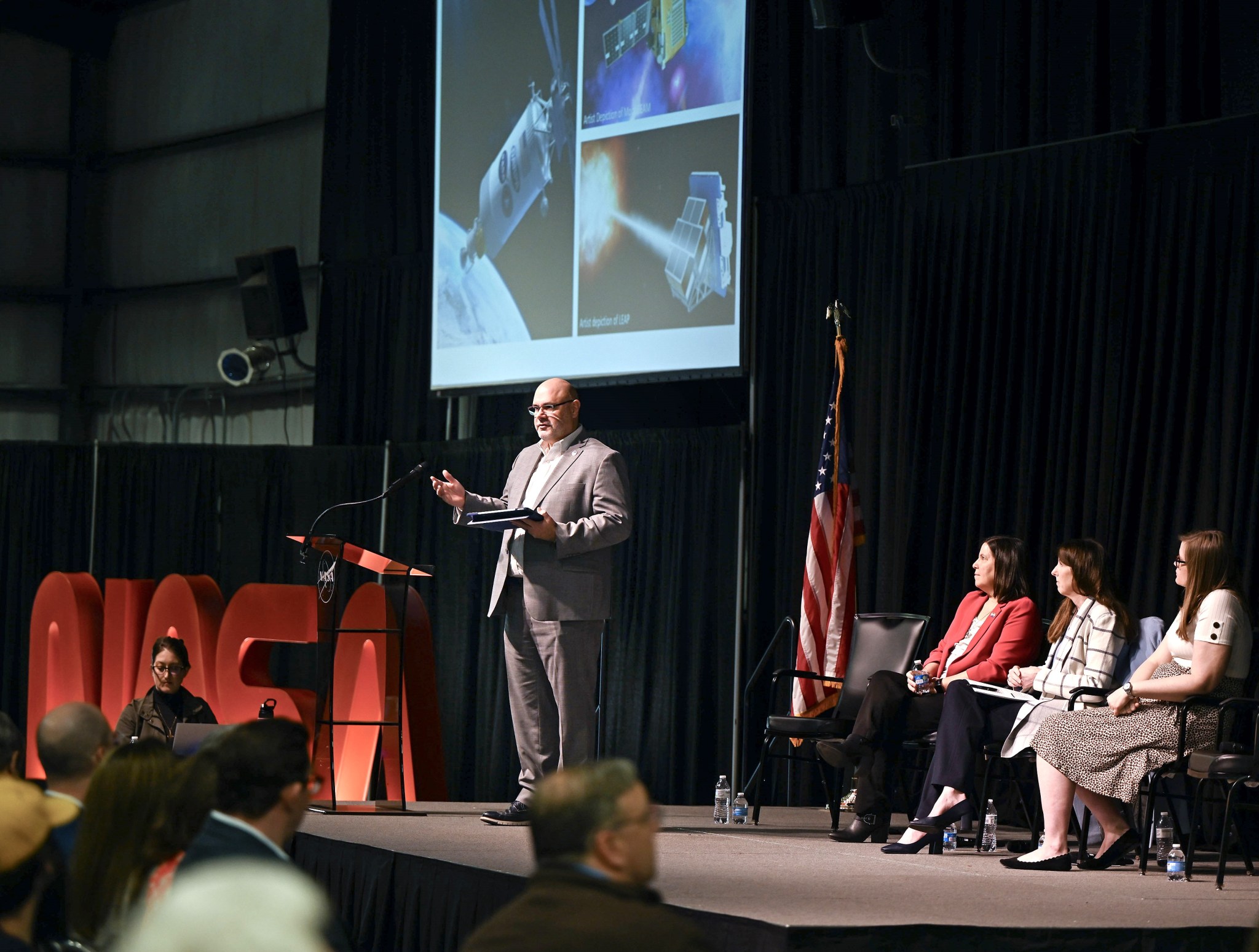
Along with Pelfrey, Tia Ferguson, director of Marshall’s Space Systems Department in the Engineering Directorate, Rae Ann Meyer, associate center director, and Mallory James, an aerospace engineer and management assistant in the office of the center director, gave presentations about the direction of Marshall in 2024.
“I see us embracing a transformative shift to a portfolio of more small and medium-sized projects enabled through strategic partnerships while also being a technical solutions provider to NASA and our partners,” Pelfrey said. “I see a very bright future for our center, and I’m excited to write this next chapter with all of you.”
Pelfrey commended Marshall team members for submitting 63 proposals to NASA’s Space Technology Mission Directorate, all enabled by partnerships. Marshall submitted and won the most proposals out of all NASA centers. He encouraged team members to continue creating and working on more innovative ideas to support future Agency needs.
Pelfrey gave updates on Marshall’s various projects, including Lunar Node-1 using the Huntsville Operation Support Center for its mission and Marshall partnering with the Italian Space Agency to create a multipurpose habitat that could be used on the Moon. The habitat is in the process of becoming a part of the Artemis architecture and would be the first of its kind on the lunar surface.
Pelfrey shared that Marshall and industry partners will be leading the development of the engine in collaboration with the Department of the Defense for NASA and DARPA’s DRACO (Demonstration Rocket for Agile Cislunar Operations), the first nuclear thermal flight demonstration intended for the mission to Mars. Pelfrey also highlighted the development of the solar sail prototype, which is approximately 4,700 square feet and was recently tested with NASA’s industry partner. The potential for this design has drawn attention from future science missions and the Department of Defense due to its advancements in propulsion.
Pelfrey also mentioned that NASA’s Michoud Assembly Facility, which is managed by Marshall, is manufacturing parts for Artemis III-V. Pertaining to the Artemis Mission, Pelfrey said the data from Artemis I is being examined to prepare for Artemis II. Flight software testing has been completed for Artemis II as well. The Human Landing System team is continuing to work with lander partner, SpaceX, which is preparing for the next Starship orbital flight test in the next few weeks.
According to Pelfrey, Marshall is also expecting two new buildings, the Marshall Exploration Facility, which is tentatively scheduled to break ground in 2026, and an Engineering Science Lab, a replacement for Building 4487.
Ferguson followed Pelfrey’s presentation with updates about NASA 2040, an agency strategic initiative propelling NASA into the future. The initiative aims to drive meaningful changes in the present to ensure that, in 2040, NASA remains the preeminent institution for research, technology, and engineering, to lead science, aeronautics, and space exploration for humanity. She went into detail about plans made to optimize the internaloperations of the agency and improving the work environment for team members to achieve mission goals.
Meyer discussed how Marshall’s culture reflects the changes and new strategies taking place. Meyer emphasized the investment in centerwide events to strengthen culture at Marshall.
James, a mentee of Meyer, gave the last presentation. She discussed the results of the Federal Employee Viewpoint Survey and how leadership is moving forward to address concerns expressed from the results.
All-hands ended with a Q&A panel with Pelfrey, Ferguson, Meyer, and James. Larry Leopard, associate director, technical, also joined the panel. They answered questions submitted online and from the audience.
“With our long history of what we’ve done at the center, there’s so much more to Marshall that we can achieve,” Pelfrey said in his closing remarks. “There’s so much more that we can dare to dream and explore and innovate for the agency and there’s more to gain when we do it together.”
Smith, a Media Fusion employee, supports the Marshall Office of Communications.
Black History Month Profile: Evolving with Leslie Smith
By Celine Smith
Ever since Leslie Smith was young, she has liked working with her hands, whether it be arts and crafts or playing the piano. Watching her father weld pieces of scrap metal into something new reinforced her enthusiasm for designing and creating.
While working for NASA’s Marshall Space Flight Center, Smith has been able to pursue her passion of more tactile work while also gaining an array of other skills.
“Helping put the next man and first woman on the Moon gives me a sense of pride, especially because it could help us get to Mars,” said Smith, who is the task manager of the Sustaining Lunar Development program. “I love knowing I’m helping the next generation and just being a part of the program.”
As a young girl, Smith aspired to be an architect, which combined her two favorite skills of designing and building. While in high school, Smith began to co-op at a technical vocational school. Her interest in architecture increased when she was introduced to CAD (computerized-aided design) software in a drafting class.
After Smith started at Tuskegee University, a historically Black university in Alabama, her sights changed. “The architecture class seemed more artsy, and not as focused on design or manufacturing, which is what I really wanted to do,” said Smith, who is from Vicksburg, Mississippi.
She decided to major in mechanical engineering instead. Before graduating, Smith signed an offer for a co-op opportunity with Marshall during a 2008 Tuskegee job fair, leading to her 15-year career at the center.
During Smith’s start, she didn’t get to immediately do the CAD work she originally was drawn to. Smith began working in the Planning and Operations branch within the Mission Ops Lab. She oversaw the countdown timeline for operational tasks and filled out functional objective sheets for the Constellation program’s Ares I. Later, she performed 3D CAD modeling for the main propulsion system and 2D drawings and assemblies for the cryogenic propellant storage and transfer system.
The experience served as Smith’s introduction to program management and systems engineering. While her role was not originally in her area of interest, she found a reason to stay.
“I stayed because of the people,” Smith said. “They were very friendly and helpful. Also, after taking a tour of Marshall, I saw all capabilities of the center. Marshall’s friction stir welding, 3D printing, the propulsion lab, and the diverse types of engineering intrigued me.”
Her first full-time role at Marshall took place after graduating college. She began as a design engineer in the Propulsion Detailed Design branch in 2013. She used her CAD skills to draft a 1 Newton thruster, an adapter for secondary payloads, and a core stage auxiliary power unit among other projects. Smith also did some friction stir welding and additive manufacturing, the processes that interested her during her co-op days. Before becoming a key coordinator for human landing systems, she conducted trade studies for SLS (Space Launch System) components as a systems engineer in 2018. Now, Smith manages human landing system concepts, focused on reducing risk and the advancement of key technologies.
“I’m the kind of person who likes to do something different every so often,” she said. “Technology is always evolving so that makes me want to always evolve.”
Smith’s passion for engineering is present in her personal life. As a member of the National Society of Black Engineers, she took part in the Arusha Project, started at NASA’s Johnson Space Center. Arusha is Swahili for “he makes fly (into the skies).” Smith joined other Black engineers to build a rover for potential Moon and Mars missions. Smith personally worked on the outer shell, window, and chassis.
“The project was great because you got to work with other African American engineers and other ethnicities,” she said. “It’s important to be around people who look like you and can relate to similar issues.”
In Smith’s free time she volunteers to do STEM outreach. She also enjoys basketball, swimming, and reading. Smith currently lives in Madison, Alabama.
Her advice for young engineers at Marshall is to: “learn all you can. Talk to as many people as you can, particularly people who are different from you for a different perspective. Never pass an opportunity to see hardware. Take all the tours and attend mentoring events.”
First in a two-part series in the Marshall Star highlighting team members during Black History Month.
Smith, a Media Fusion employee, supports the Marshall Office of Communications.
Deputy Director of NASA Safety Center Speaker for Feb. 22 Mission Success Forum
By Wayne Smith
Bob Conway, deputy director of the NASA Safety Center, will be the guest speaker for the Mission Success Is in Our Hands hybrid Shared Experiences Forum on Feb. 22 at NASA’s Marshall Space Flight Center.
The 11:30 a.m. event will be in Activities Building 4316 for Marshall team members. Light refreshments will be served. The forum is available to NASA employees and the public virtually via Teams.
Mission Success Is in Our Hands is a safety initiative collaboration between NASA’s Marshall Space Flight Center and Jacobs Engineering. The initiative’s goal to help team members make meaningful connections between their jobs and the safety and success of NASA and Marshall missions.
The theme of the forum is “The Impact of Breaking the Silence.” Conway will address the elements and factors that can contribute to organizational silence, including the failure to draw attention to problems that can potentially result in mission failures. He will detail practical tactics and tools to help combat this issue and identify methods of creating organizational excellence from the perspectives of both leadership and front-line employees.
Bill Hill, director of Safety and Mission Assurance at Marshall, encourages team members to attend the forum in-person.
“Administrator (Bill) Nelson has requested that all NASA civil servants and contractors hear Bob Conway’s organizational silence briefing and learn tools and techniques to avoid the pitfalls of organizational silence,” Hill said.
Jeff Haars, Jacobs vice president and program manager for Jacobs Space Exploration Group, said the Shared Experiences Forum is an impactful reminder on safety.
“At Jacobs, we put a high priority on safety so it’s very reassuring to have a great safety partner like Marshall,” Haars said. “Working as a team allows us to deliver our work safely while contributing to mission success.”
Conway works with the NASA Safety Center’s director to enable more effective and efficient safety and mission assurance support for NASA’s portfolio of programs and projects by managing the safety center’s activities in knowledge sharing and analysis, technical excellence, and assessments and investigations.
Prior to assuming this role, Conway worked in the civilian sector as the manager of Quality Engineering for Worldwide Safety and Health at the Walt Disney World Resort in Orlando, Florida, from 2012 to 2019. Conway was also a member of the NASA Aerospace Safety Advisory Panel from 2012 to 2016. In this role he evaluated various NASA programs and, with his Naval Aviation Safety background, was the lead panel representative to the NASA Aircraft Mission Directorate. After his commissioning as an ensign, Conway served in the U.S. Navy through his retirement in 2012.
As part of the forum, Mission Success Is in Our Hands will present the Golden Eagle Award to a Marshall team member. The award promotes awareness and appreciation for flight safety, as demonstrated through the connections between employees’ everyday work, the success of NASA and Marshall’s missions, and the safety of NASA astronauts. The award recognizes individuals who have made significant contributions to flight safety and mission assurance above and beyond their normal work requirements. Management or peers can nominate any team member for the award. Honorees are typically recognized at quarterly Shared Experiences forums.
Smith, a Media Fusion employee and the Marshall Star editor, supports the Marshall Office of Communications.
NASA Science Aboard Intuitive Machines Continues Journey to Moon, Landing Coverage set for Feb. 22
After a successful launch Feb. 15, six NASA science instruments and technology demonstrations continue their journey to the Moon aboard Intuitive Machines’ lander named Odysseus. The company confirmed communications contact with its mission operations control in Houston, and its lander continues to perform as expected.
As part of NASA’s CLPS (Commercial Lunar Payload Services) initiative and Artemis campaign, Intuitive Machines is targeting no earlier than 4:49 p.m. CST on Feb. 22 to land their Odysseus lunar lander near Malapert A in the South Pole region of the Moon.
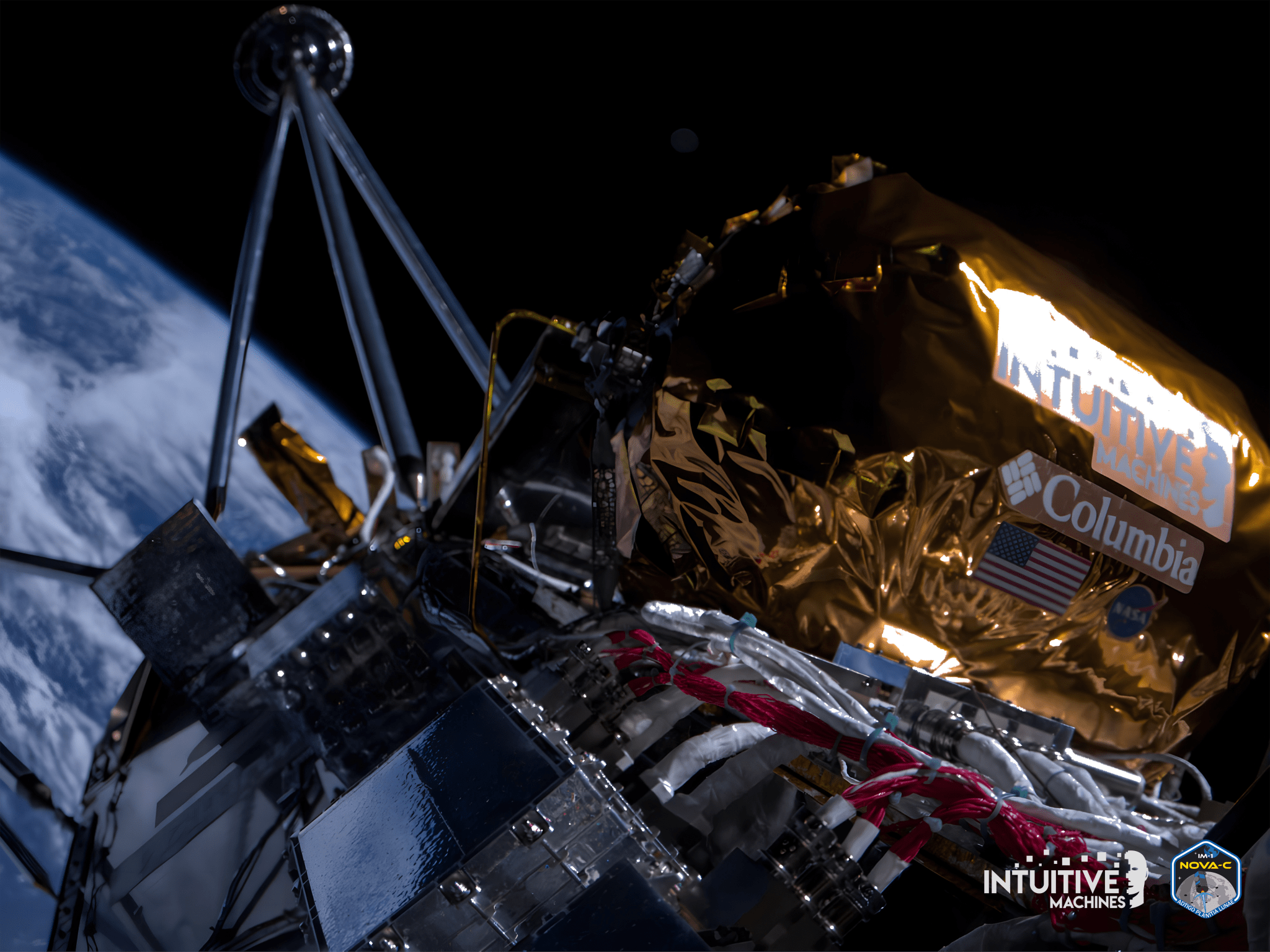
Live landing coverage will air on NASA+, NASA Television, the NASA app, and the agency’s website. NASA TV can be streamed on a variety of platforms, including social media. Coverage will include live streaming and blog updates beginning 3:15 p.m., as the landing milestones occur. Upon successful landing, Intuitive Machines and NASA will host a news conference to discuss the mission and science opportunities that lie ahead as the company begins lunar surface operations.
Known as IM-1, Intuitive Machines successfully transmitted its first images back to Earth on Feb. 16. These were captured shortly after separation from SpaceX’s second stage, on Intuitive Machines’ first journey to the Moon.
Within an hour of launching, NASA confirmed data was streaming from the agency’s powered science and technology instruments aboard the flight. This means data from these instruments was automatically streaming back to the teams so NASA could monitor the health and status of its instruments.
Later, Intuitive Machines successfully commissioned Odysseus’ engine which means they exercised the engine’s complete flight profile, including the throttling required for landing. The engine, which uses liquid methane and liquid oxygen, is the first of its kind fired in space.
One of the NASA instruments, the Radio Frequency Mass Gauge is gauging the cryogenic propellants on Odysseus throughout the mission. Data files have been collected and many have been downloaded for analysis. Throughout the propellant loading phase that took place before launch, the instrument collected data, which was downloaded and analyzed in near-real time. Data also is being collected during the microgravity transit phase of the mission. This analysis will continue through landing on the Moon.
Another NASA instrument, Lunar Node-1, or LN-1, integrates navigation and communication . LN-1 was developed, built, and tested at NASA’s Marshall Space Flight Center. This science instrument will operate daily during the cruise phase as the landing date draws closer. The radio beacon is designed to support precise geolocation and navigation observations to orbiters, landers, and surface personnel, digitally confirming their positions on the Moon relative to other craft, ground stations, or rovers on the move. The check-out helps prepare to land on the Moon as the navigation demonstrator aims to gather this data throughout the duration of the surface operations phase of the mission. Flight controllers will analyze the data from this procedure to inform preparations for landing Feb. 22.
Follow the Artemis blog for updates, or follow along with Intuitive Machines for the latest operational updates on their mission.
Rocket Propellant Tanks for NASA’s Artemis III Mission Take Shape
With the liquid oxygen tank now fully welded, all the major structures that will form the core stage for NASA’s SLS (Space Launch System) rocket for the agency’s Artemis III mission are ready for additional outfitting.
The hardware will be a part of the rocket used for the first of the Artemis missions planning to land astronauts on the Moon’s surface near the lunar South Pole. Technicians finished welding the 51-foot liquid oxygen tank structure inside the Vertical Assembly Building at NASA’s Michoud Assembly Facility on Jan. 8.
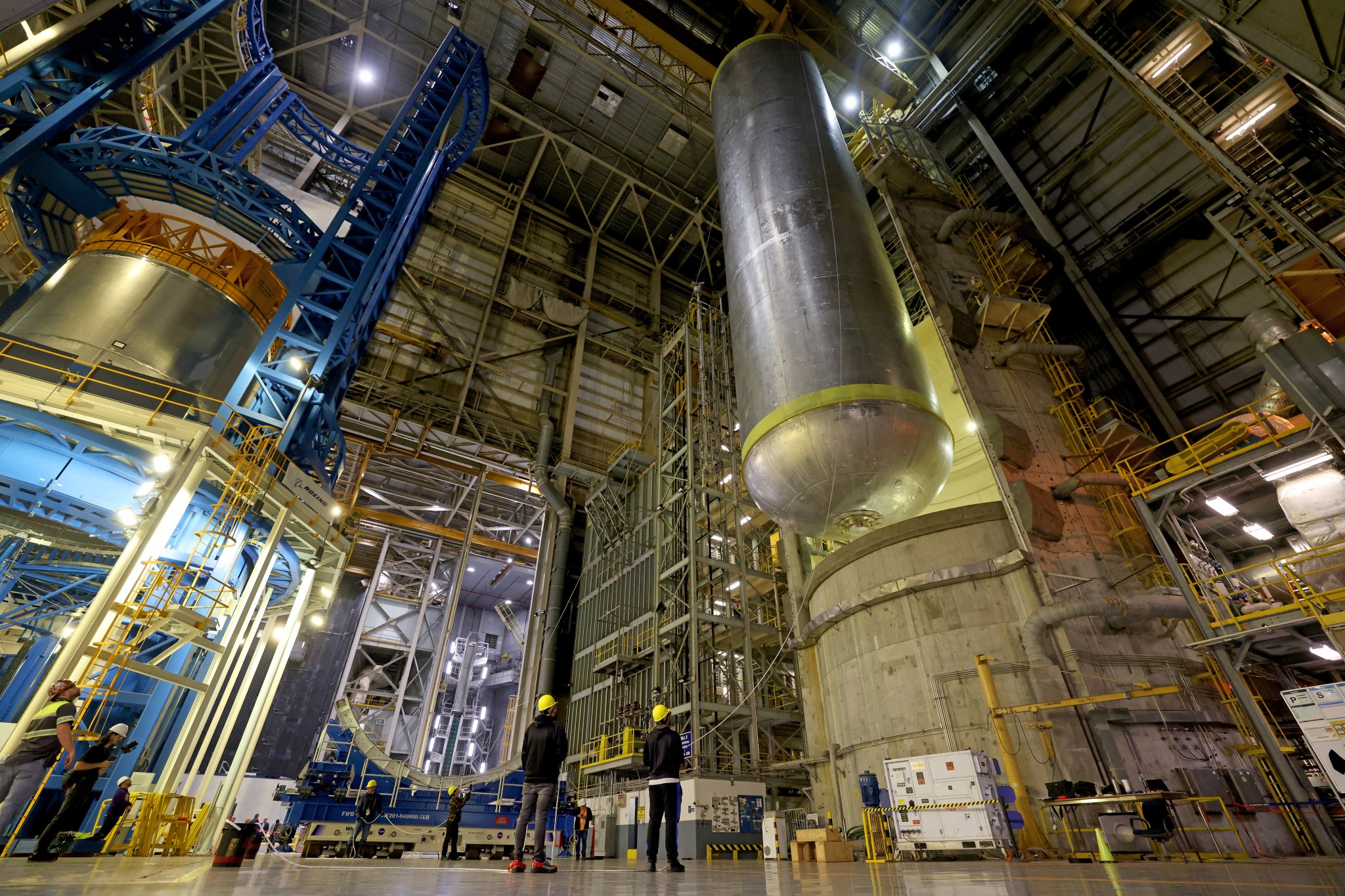
The mega rocket’s other giant propellant tank – the liquid hydrogen tank – is already one fully welded structure. NASA and Boeing, the SLS core stage lead contractor, are currently priming the tank in another cell within the Vertical Assembly Building area called the Building 131 cryogenic tank thermal protection system and primer application complex. It completed internal cleaning Nov. 14.
Manufacturing hardware is a multi-step process that includes welding, washing, and, later, outfitting hardware. The internal cleaning process is similar to a shower to ensure contaminants do not find their way into the stage’s complex propulsion and engine systems prior to priming. Once internal cleaning is complete, primer is applied to the external portions of the tank’s barrel section and domes by an automated robotic tool. Following primer, technicians apply a foam-based thermal protection system to shield it from the extreme temperatures it will face during launch and flight while also regulating the super-chilled propellant within.
“NASA and its partners are processing major hardware elements at Michoud for several SLS rockets in parallel to support the agency’s Artemis campaign,” said Chad Bryant, acting manager of the Stages Office for NASA’s SLS Program. “With the Artemis II core stage nearing completion, the major structural elements of the SLS core stage for Artemis III will advance through production on the factory floor.”
The two massive propellant tanks for the rocket collectively hold more than 733,000 gallons of super-chilled propellant. The propellant powers the four RS-25 engines and must stay extremely cold to remain liquid.
The core stage, along with the RS-25 engines, will produce two million pounds of thrust to help launch NASA’s Orion spacecraft, astronauts, and supplies beyond Earth’s orbit and to the lunar surface for Artemis III. SLS is the only rocket that can send Orion, astronauts, and supplies to the Moon in a single launch.
Through Artemis, NASA will send astronauts – including the first woman, first person of color, and first international partner astronaut – to explore the Moon for scientific discovery, economic benefits, and to build the foundation for crewed mission to Mars. SLS is part of NASA’s backbone for deep space exploration, along with the Orion spacecraft, exploration ground systems, advanced spacesuits and rovers, Gateway, and human landing systems.
NASA’s Marshall Space Flight Center manages the SLS Program and Michoud Assembly Facility.
Artemis II Mission Manager: Matthew Ramsey
Matthew Ramsey is keenly aware of the responsibility he shoulders to ensure NASA’s missions to the Moon are safe and successful. As the mission manager for Artemis II, NASA’s first crewed mission under Artemis, Ramsey is charged with helping to define the requirements and priorities for the missions and certifying that the hardware and operations needed to support flight are ready.
“For me, it’s all about the crew and ensuring their safety as they venture to the Moon and come home,” Ramsey said. “Sending people thousands of miles from home and doing it in a way that sets the stage for long-term exploration and scientific discovery is an incredibly complex task.”
During the leadup to Artemis II, Ramsey is responsible for oversight of the daily preparations as NASA prepares to launch and fly the agency’s SLS (Space Launch System) rocket with a crew of four inside the Orion spacecraft. He will adjudicate issues that arise in the weeks and months ahead of the flight test and serve as deputy of the Mission Management Team – a tiger team that forms two days before launch to accept the risks associated with the mission and make decisions during the flight to address any changes or concerns.
A native of Hernando, Mississippi, Ramsey pitched for the Mississippi State University baseball team before earning bachelor’s and master’s degrees in aerospace engineering from the school.
“There are a lot of similarities between mission management and pitching,” he said. “You control many aspects of the tempo, and there’s a lot of weight on your shoulders.”
Ramsey began his career in the intelligence and defense sectors before joining the space agency in 2002 to work on guidance, navigation, and control for the X-37 Approach and Landing Test Vehicle. Later, he worked on the design of the Ares I and V rockets as part of NASA’s Constellation Program before transitioning in 2010 to the SLS Program in support of the chief engineer at the agency’s Marshall Space Flight Center.
During the Artemis I launch, Ramsey was the SLS Engineering Support Center manager at Marshall, coordinating across engineering teams to provide data and solutions to issues encountered during the multiple launch attempts. He then supported the Mission Management Team during Artemis I in an observational role, preparing for his position as Artemis II mission manager.
While NASA and its partners are preparing for Artemis II, work toward other Artemis missions is also underway. Ramsey also will serve as the mission manager for Artemis IV, the first Gateway assembly mission that also will include a lunar landing.
“With Artemis II on the horizon, most of my time is focused on making sure we’re ready to fly Reid, Victor, Christina, and Jeremy around the Moon and bring them safely home,” Ramsey said. “For Artemis IV, we’re in the mission concept-planning phase, establishing mission priorities and objectives and defining how we’ll transfer crew between all the hardware elements involved.”
As Artemis II nears, Ramsey is blending his operational experience and expertise in design, development, testing, and evaluation so that NASA is primed for what lies ahead: sending humans back to the Moon for the first time in more than 50 years and laying the foundation for future missions that will ultimately enable human exploration of Mars.
Teams Add Iconic NASA ‘Worm’ Logo to Artemis II Rocket, Spacecraft
Art and science merged as teams added the NASA “worm” logo on the SLS (Space Launch System) solid rocket boosters and the Orion spacecraft’s crew module adapter at NASA’s Kennedy Space Center for the agency’s Artemis II mission.
The iconic logo was introduced in 1975 by the firm of Danne & Blackburn as a modern emblem for the agency. It emerged from a nearly 30-year retirement in 2020 for limited use on select missions and products.
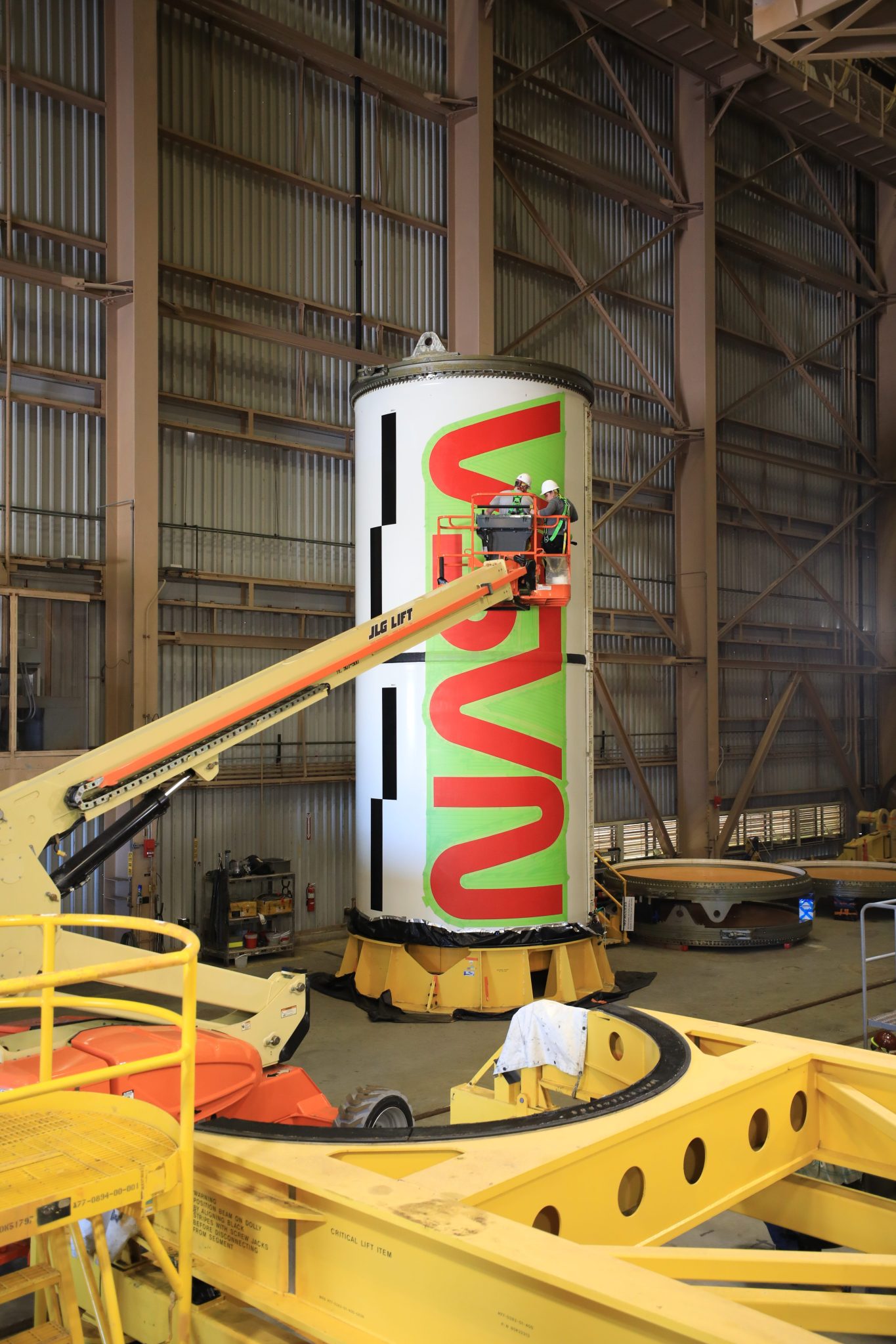
NASA’s Exploration Ground Systems and prime contractor Jacobs began painting the red logotype onto the segments that form the Moon rocket’s two solid rocket boosters Jan. 22. To do so, crews used a laser projector to first mark off the location of the logo with tape, then applied two coats of paint and finished by adding several coats of clear primer. Each letter of the worm logo measures approximately 6 feet and 10 inches in height and altogether, stretches 25 feet from end to end, or a little less than the length of one of the rocket’s booster motor segments.
The location of the worm logo will be moderately different from where it was during Artemis I. While it will still be located on each of the rocket’s 17 story boosters, the modernist logo will be placed toward the front of the booster systems tunnel cover. The SLS boosters are the largest, most powerful solid propellant boosters ever flown and provide more than 75% of the thrust at launch.
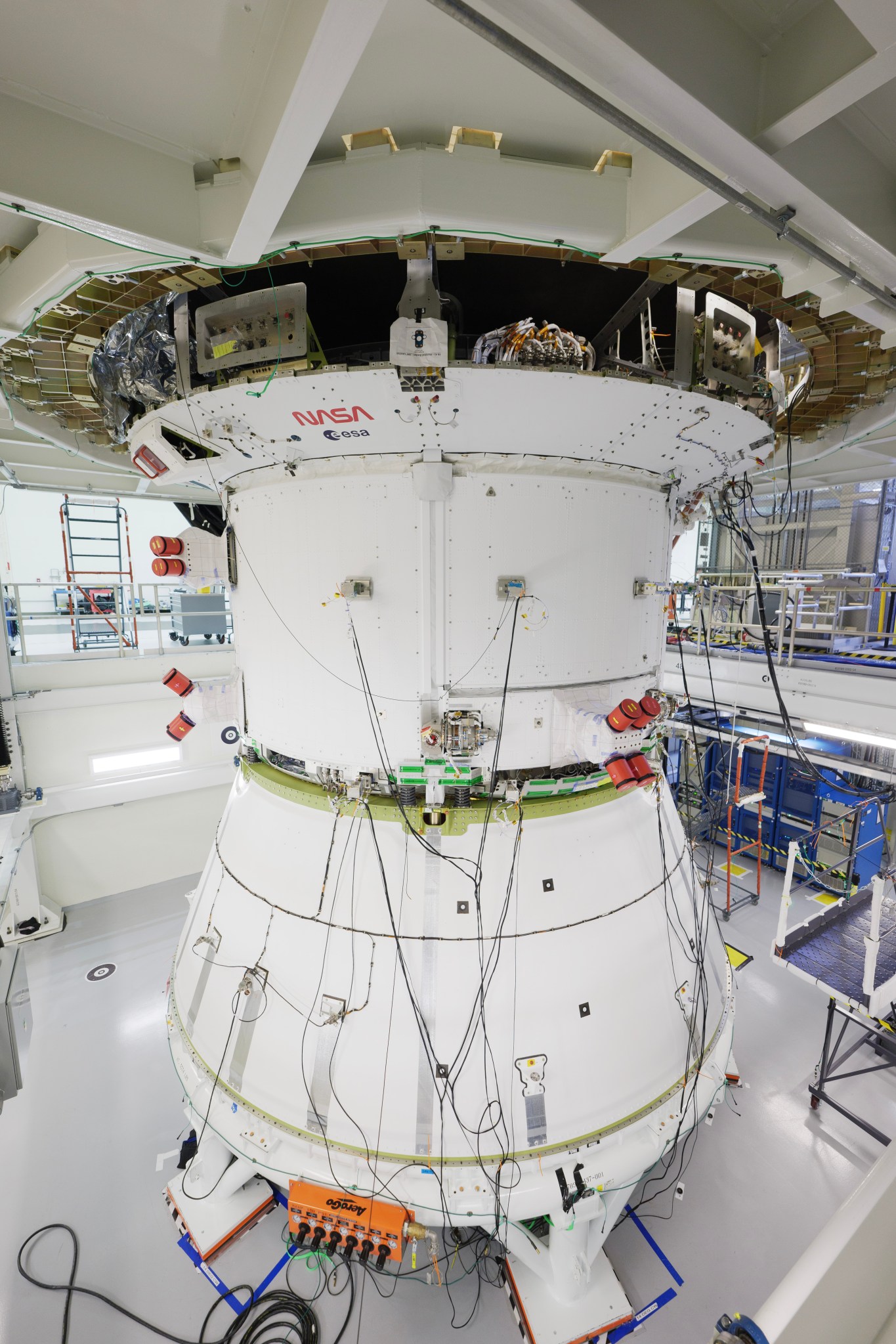
Around the corner inside the Neil Armstrong Operations and Checkout Building at Kennedy, personnel adhered the worm logo and ESA (European Space Agency) insignia Jan. 28 on the spacecraft’s crew module adapter. The adapter houses electronic equipment for communications, power, and control, and includes an umbilical connector that bridges the electrical, data, and fluid systems between the main modules.
In October 2023, technicians joined the crew and service modules together. The crew module will house the four astronauts as they journey around the Moon and back to Earth on an approximately 10-day journey. The spacecraft’s service module, provided by ESA, will supply the vehicle with electricity, propulsion, thermal control, air, and water in space.
NASA is working to land the first woman, first person of color, and first international partner astronaut on the Moon through Artemis. SLS and the Orion spacecraft are central to NASA’s deep space exploration plans, along with advanced spacesuits and rovers, the Gateway space station planned for orbit around the Moon, and commercial human landing systems.
NASA’s Marshall Space Flight Center manages the SLS Program.
Chandra: Black Hole Fashions Stellar Beads on A String
Astronomers have discovered one of the most powerful eruptions from a black hole ever recorded in the system known as SDSS J1531+3414 (SDSS J1531 for short). This mega-explosion billions of years ago may help explain the formation of a striking pattern of star clusters around two massive galaxies, resembling “beads on a string.”
SDSS J1531 is a massive galaxy cluster containing hundreds of individual galaxies and huge reservoirs of hot gas and dark matter. At the center of SDSS J1531, which is located about 3.8 billion light-years away, two of the cluster’s largest galaxies are colliding with each other.
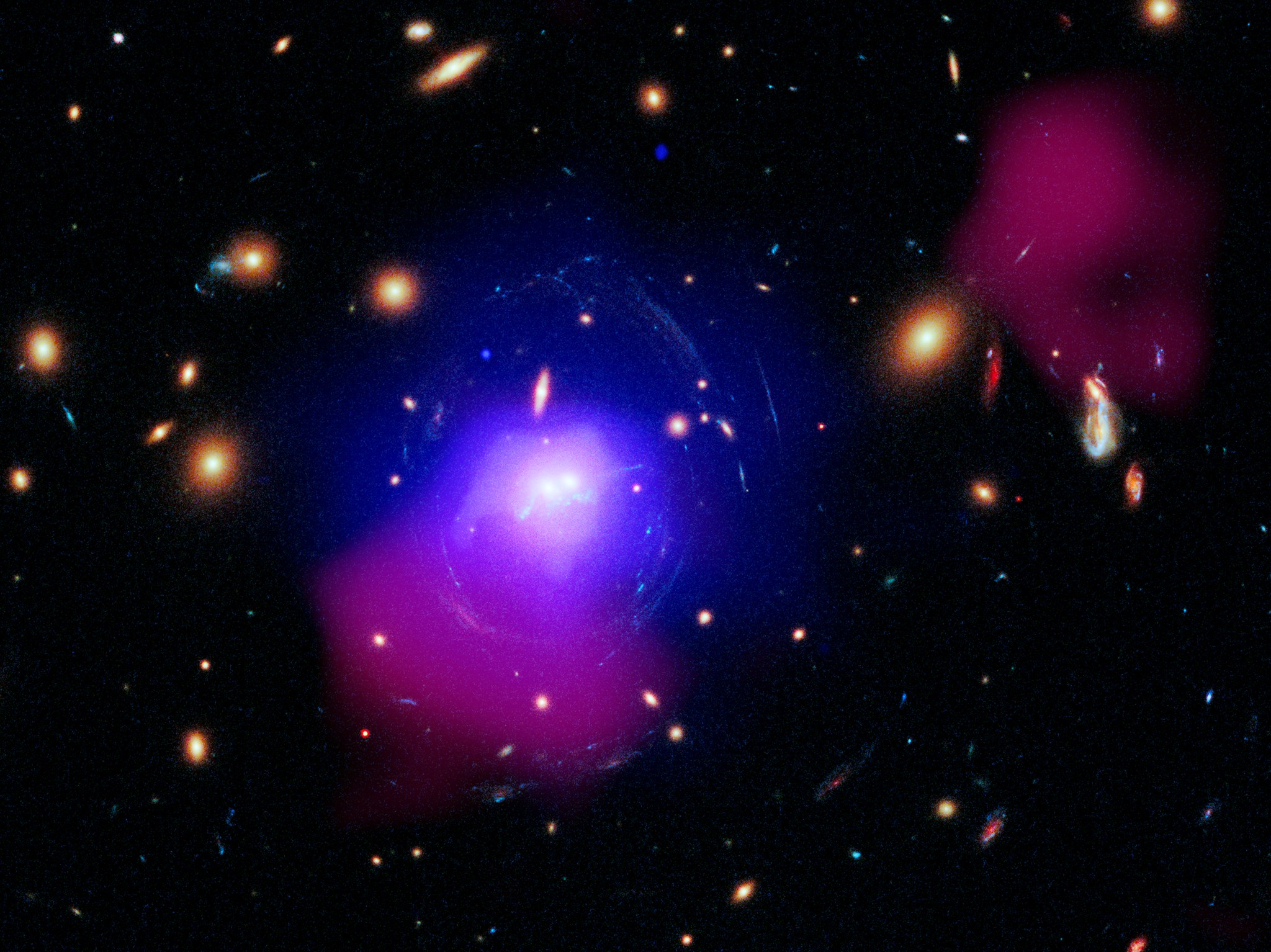
Astronomers used several telescopes to study SDSS J1531 including NASA’s Chandra X-ray Observatory, and LOFAR (Low Frequency Array), a radio telescope. A composite image shows SDSS J1531 in X-rays from Chandra (blue and purple) that have been combined with radio data from LOFAR (dark pink) as well as an optical image from the Hubble Space Telescope (appearing as yellow and white). The inset gives a close-in view of the center of SDSS J1531 in optical light, showing the two large galaxies and a set of 19 large clusters of stars, called superclusters, stretching across the middle. The image shows these star clusters are arranged in an ‘S’ formation that resembles beads on a string.
The multiwavelength data provides signs of an ancient, titanic eruption in SDSS J1531, which a team of researchers think was responsible for creation of the 19 star clusters. Their argument is that an extremely powerful jet from the supermassive black holes in the center of one of the large galaxies pushed the surrounding hot gas away from the black hole, creating a gigantic cavity. The evidence for a cavity comes from “wings” of bright X-ray emission, seen with Chandra, tracing dense gas near the center of SDSS J1531. These wings are the edge of the cavity and the less dense gas in between is part of the cavity. LOFAR shows radio waves from the remains of the jet’s energetic particles filling in the giant cavity. These features are highlighted in a labeled version of the image.
The astronomers also discovered cold and warm gas located near the opening of the cavity, detected with the Atacama Large Millimeter and submillimeter Array and the Gemini North Telescope, respectively. A separate graphic shows the optical image with the cold gas added in green (left), and the warm gas added in red (right). The team argues that some of the hot gas pushed away from the black hole eventually cooled to form the cold and warm gas shown. The team thinks tidal effects from the two merging galaxies compressed the gas along curved paths, leading to the star clusters forming in the “beads on a string” pattern.
A paper led by Osase Omoruyi of the Center for Astrophysics | Harvard & Smithsonian (CfA) describing these results has recently been published in The Astrophysical Journal and is available online here. The authors of the paper are Grant Tremblay (CfA), Francoise Combes (Paris Observatory, France), Timothy Davis (Cardiff University, UK), Michael Gladders (University of Chicago), Alexey Vikhlinin (CfA), Paul Nulsen (CfA), Preeti Kharb (National Centre for Radio Astrophysics – Tata Institute of Fundamental Research, India), Stefi Baum (University of Manitoba, Canada), Christopher O’Dea (University of Manitoba, Canada), Keren Sharon (University of Michigan), Bryan Terrazas (Columbia University), Rebecca Nevin (Fermi National Accelerator Laboratory), Aimee Schechter (University of Colorado Boulder), John ZuHone (CfA), Michael McDonald (Massachusetts Institute of Technology), Hakon Dahle (University of Oslo, Norway), Matthew B. Bayliss (University of Cincinnati), Thomas Connor (CfA), Michael Florian (University of Arizona), Jane Rigby (NASA Goddard Space Flight Center), and Sravani Vaddi (Arecibo Observatory).
NASA’s Marshall Space Flight Center manages the Chandra program. The Smithsonian Astrophysical Observatory’s Chandra X-ray Center controls science operations from Cambridge, Massachusetts, and flight operations from Burlington, Massachusetts.
New Horizons Detects Dusty Hints of Extended Kuiper Belt
New observations from NASA’s New Horizons spacecraft hint that the Kuiper Belt – the vast, distant outer zone of our solar system populated by hundreds of thousands of icy, rocky planetary building blocks – might stretch much farther out than we thought.
Speeding through the outer edges of the Kuiper Belt, almost 60 times farther from the Sun than Earth, the New Horizons SDC (Venetia Burney Student Dust Counter) instrument is detecting higher than expected levels of dust – the tiny frozen remnants of collisions between larger Kuiper Belt objects, or KBOs, and particles kicked up from KBOs being peppered by microscopic dust impactors from outside of the solar system.
The readings defy scientific models that the KBO population and density of dust should start to decline a billion miles inside that distance and contribute to a growing body of evidence that suggests the outer edge of the main Kuiper Belt could extend billions of miles farther than current estimates – or that there could even be a second belt beyond the one we already know.
The results appear in the Feb. 1 issue of the Astrophysical Journal Letters.
“New Horizons is making the first direct measurements of interplanetary dust far beyond Neptune and Pluto, so every observation could lead to a discovery,” said Alex Doner, lead author of the paper and a physics graduate student at the University of Colorado Boulder who serves as SDC lead. “The idea that we might have detected an extended Kuiper Belt – with a whole new population of objects colliding and producing more dust – offers another clue in solving the mysteries of the solar system’s most distant regions.”
Designed and built by students at the Laboratory for Atmospheric and Space Physics (LASP) at the University of Colorado Boulder under the guidance of professional engineers, SDC has detected microscopic dust grains produced by collisions among asteroids, comets and Kuiper Belt objects all along New Horizons’ 5-billion-mile, 18-year journey across our solar system – which after launch in 2006 included historic flybys of Pluto in 2015 and the KBO Arrokoth in 2019. The first science instrument on a NASA planetary mission to be designed, built and “flown” by students, the SDC counts and measures the sizes of dust particles, producing information on the collision rates of such bodies in the outer solar system.
The latest, surprising results were compiled over three years as New Horizons traveled from 45 to 55 AU (astronomical units from the Sun – with one AU being the distance between Earth and Sun, about 93 million miles.
These readings come as New Horizons scientists, using observatories like the Japanese Subaru Telescope in Hawaii, have also discovered a number KBOs far beyond the traditional outer edge of the Kuiper Belt. This outer edge (where the density of objects starts to decline) was thought to be at about 50 AU, but new evidence suggests the belt may extend to 80 AU, or farther.
As telescope observations continue, Doner said, scientists are looking at other possible reasons for the high SDC dust readings. One possibility, perhaps less likely, is radiation pressure and other factors pushing dust created in the inner Kuiper Belt out past 50 AU. New Horizons could also have encountered shorter-lived ice particles that cannot reach the inner parts of the solar system and were not yet accounted for in the current models of the Kuiper Belt.
“These new scientific results from New Horizons may be the first time that any spacecraft has discovered a new population of bodies in our solar system,” said Alan Stern, New Horizons principal investigator from the Southwest Research Institute in Boulder. “I can’t wait to see how much farther out these elevated Kuiper Belt dust levels go.”
Now into its second extended mission, New Horizons is expected to have sufficient propellant and power to operate through the 2040s, at distances beyond 100 AU from the Sun. That far out, mission scientists say, the SDC could potentially even record the spacecraft’s transition into a region where interstellar particles dominate the dust environment. With complementary telescopic observations of the Kuiper Belt from Earth, New Horizons, as the only spacecraft operating in and collecting new information about the Kuiper Belt, has a unique opportunity to learn more about KBOs, dust sources and expanse of the belt, and interstellar dust and the dust disks around other stars.
The Johns Hopkins Applied Physics Laboratory in Laurel, Maryland, built and operates the New Horizons spacecraft and manages the mission for NASA’s Science Mission Directorate. Southwest Research Institute, based in San Antonio and Boulder, Colorado, directs the mission via Principal Investigator Alan Stern and leads the science team, payload operations and encounter science planning. New Horizons is part of NASA’s New Frontiers Program, managed by NASA’s Marshall Space Flight Center.


























